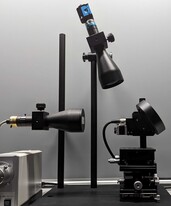
In this study, we introduced a measurement method for gloss unevenness as a function of reflectance angles. Gloss is one of the most important qualities of materials, and it is evaluated subjectively by the intensity of reflected light and gloss unevenness. People can estimate the texture of a material using gloss unevenness, which is found in the small peripheral part of the gloss area and can easily be recognized by observing the reflected light while moving the object or eyes. However, it is not easy to photograph and quantify gloss unevenness. One reason is the area where gloss unevenness is observed is a small area near specular reflection. Second, the appearance of gloss unevenness changes depending on the reflection angle. We developed a measurement apparatus to measure gonio-photometric gloss unevenness. We introduced two solutions: a wide-area gloss unevenness measurement technology using telecentric imaging and a rotating mirror optical system that defects reflected light at an angular resolution of 0.02°. We analyzed three materials—mirror, plastic, and paper—and proposed three indicators as a quantitative evaluation method for gloss: intensity of reflected light at the specular angle, full width at half maximum (FWHM) of Bidirectional Reflectance Distribution Function (BRDF), and gloss unevenness image at the FWHM.